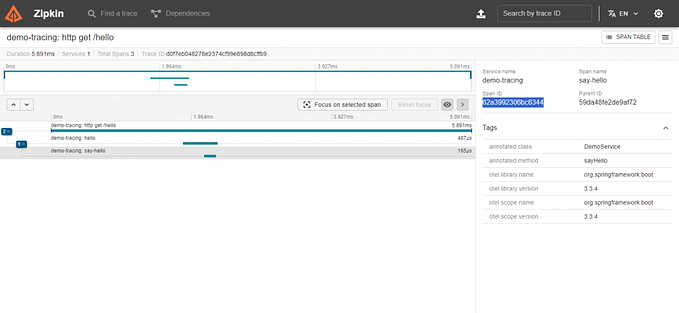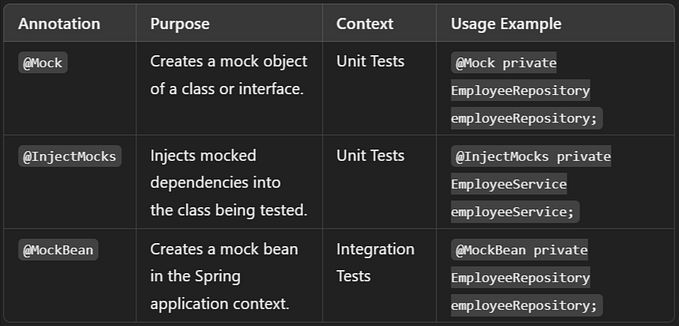Testing Microservices with Testcontainers
Spring Boot integration tests that rock!
When writing integration tests for Spring Boot applications, we usually need to access external resources such as databases, message brokers, webservices, etc. One of the goals of integration testing should be to verify precisely how the different parts of an application behave in combination with these external resources.
We will explore in this article how a library like Testcontainers can help us to achieve a better integration testing design.
How Testcontainers Works?
This library provides lightweight containerized instances of resources, like databases, messages brokers, and web servers. In order to use it, it requires a Docker environment up and running on your machine.
Testcontainers is supported by Junit4, Junit5 and Spock. However, in the following examples we will use Junit5 as the testing framework and Java 17.
The SUT
To show how to use Testcontainers, let me propose the following System Under Test (SUT), which is intended to be a simplistic approximation of what a real-life microservice would be.

Here, the Payment Service consumes Payment Events from a RabbitMQ queue, stores the transactional data on a PostgreSQL database, and calls the Card Service to verify if the Card Details provided are valid.
The Core Business
The SUT described above includes the following Core Business classes:
- Payment Method:
public enum PaymentMethod {
CARD, CASH
}- Payment Status:
public enum PaymentStatus {
PENDING_VALIDATION, OK, ERROR
}- Payment:
public record Payment(BigDecimal amount,
PaymentMethod paymentMethod,
@Nullable CardDetails card) {
public Payment(BigDecimal amount, PaymentMethod paymentMethod) {
this(amount, paymentMethod, null);
}
}- Card Details:
public record CardDetails(String number, int expDate, int cvc) {
}- Payment Service
@Service
public class PaymentService {
private final PaymentDao paymentDao;
private final CardServiceProxy cardService;
public PaymentServiceImpl(PaymentDao paymentDao, CardServiceProxy cardService) {
this.paymentDao = paymentDao;
this.cardService = cardService;
}
@Transactional
public void registerPayment(Payment payment) {
if (Objects.equals(payment.paymentMethod(), PaymentMethod.CARD)) {
UUID id = paymentDao.create(payment, PaymentStatus.PENDING_VALIDATION);
boolean isValidCard = cardService.validateCard(payment.card());
paymentDao.updateStatus(id,
isValidCard ? PaymentStatus.OK : PaymentStatus.ERROR);
} else {
paymentDao.create(payment, PaymentStatus.OK);
}
}
}Here, Business Logic is encapsulated in the registerPayment() method:
- If the Payment Method is CASH, it creates a Payment with a Status set to
OK - If the Payment Method is CARD, it creates a Payment with a status set to
PENDING_VALIDATION, validates the Card Details through theCardServiceProxyclass, and updates the Payment to statusOKorERROR, depending on whether the card is valid or not.
Setting Up the Project
Testcontainers is distributed along separate dependencies.
In this tutorial, we will use Gradle as the build tool. So, let’s add the following test dependencies to the build.gradle file:
testImplementation "org.testcontainers:testcontainers:${testcontainersVersion}"
testImplementation "org.testcontainers:junit-jupiter:${testcontainersVersion}"
testImplementation "org.testcontainers:postgresql:${testcontainersVersion}"
testImplementation "org.testcontainers:rabbitmq:${testcontainersVersion}"Let’s also configure the application.yml file with the following properties:
spring:
rabbitmq:
host: localhost
port: 5672
username: guest
password: guest
datasource:
url: jdbc:postgresql://localhost:5432/mydb?currentSchema=payment_service
username: username
password: password
driver-class-name: org.postgresql.Driver
ws:
card:
base-url: http://localhost:8181
validate-uri: v1/cards/validateIntegration Testing with PostgreSQL Containers
The Database Layer
- Payment JPA Entity:
@Entity
@Table(schema = "payment_service", name = "payment")
@Access(AccessType.FIELD)
public class PaymentJpaEntity {
@Id
@GeneratedValue(generator = "UUID")
@GenericGenerator(name = "UUID", strategy = "org.hibernate.id.UUIDGenerator")
private UUID id;
private BigDecimal amount;
@Enumerated(EnumType.STRING)
private PaymentMethod paymentMethod;
@Enumerated(EnumType.STRING)
private PaymentStatus paymentStatus;
@CreationTimestamp
private Instant paymentDate;
// methods removed for simplicity
}- Payment JPA Repository:
public interface PaymentJpaRepository
extends JpaRepository<PaymentJpaEntity, UUID> {
}- Payment DAO (Data Access Object):
@Component
public class PaymentDao {
private static final Logger log = LoggerFactory.getLogger(PaymentDao.class);
private final PaymentJpaRepository jpaRepository;
public PaymentDao(PaymentJpaRepository jpaRepository) {
this.jpaRepository = jpaRepository;
}
public UUID create(Payment payment, PaymentStatus status) {
PaymentJpaEntity paymentCreated = jpaRepository.save(
new PaymentJpaEntity(
payment.amount(),
payment.paymentMethod(),
status
)
);
log.debug("Payment created: {}", paymentCreated);
return paymentCreated.getId();
}
public boolean updateStatus(UUID paymentId, PaymentStatus status) {
AtomicBoolean updated = new AtomicBoolean(false);
jpaRepository.findById(paymentId)
.ifPresent(payment -> {
payment.setPaymentStatus(status);
jpaRepository.save(payment);
log.debug("Payment updated: {}", payment);
updated.set(true);
});
return updated.get();
}
}Creating the Integration Test
First, let’s create a Java Interface with a container to reuse with the different test classes.
@Testcontainers
public interface PostgresTestContainer {
String DOCKER_IMAGE_NAME = "postgres:15";
@Container
PostgreSQLContainer<?> container =
new PostgreSQLContainer<>(DOCKER_IMAGE_NAME);
@DynamicPropertySource
static void registerProperties(DynamicPropertyRegistry registry) {
registry.add("spring.datasource.url", container::getJdbcUrl);
registry.add("spring.datasource.username", container::getUsername);
registry.add("spring.datasource.password", container::getPassword);
}
}Here:
- The
@Testcontainersannotation is required to use the Testcontainers extension for JUnit. - The
@Containerannotation is required for the instance of the container. - The
PostgreSQLContaineris the specific container class that we are using for PostgreSQL. This class receives the docker image name as an argument in the constructor, and creates an instance with a dynamic url, username and password. - The
@DynamicPropertySourceannotation allows to add properties with the dynamic values provided by Testcontainer. By declaring an instance ofDynamicPropertyRegistryas a method argument, you can use theadd()method to replace thespring.datasource.*properties with the following values:
-container.getJdbcUrl()(gets the JDBC URL to connect to)
-container.getUsername()(gets the database username)
-container.getPassword()(gets the database password)
Next, to test the PaymentDao class, let’s implement the PostgresTestContainer interface in the test class.
@DataJpaTest
@ComponentScan(basePackages = {"ports.output.jpa"})
@AutoConfigureTestDatabase(replace = AutoConfigureTestDatabase.Replace.NONE)
@TestMethodOrder(MethodOrderer.OrderAnnotation.class)
class PaymentDaoIntegrationTest implements PostgresTestContainer {
static UUID paymentId;
@Autowired
PaymentDao dao;
@Test
@Order(1)
@Commit
void create_test() {
paymentId = dao.create(
new Payment(BigDecimal.TEN, PaymentMethod.CARD),
PaymentStatus.PENDING_VALIDATION
);
assertThat(paymentId).isNotNull();
}
@Test
@Order(2)
void updateStatus_test_withExistingPaymentId() {
assertThat(dao.updateStatus(paymentId, PaymentStatus.OK))
.isTrue();
}
@Test
@Order(3)
void updateStatus_test_withNonExistingPaymentId() {
UUID randomPaymentId = UUID.randomUUID();
assertThat(dao.updateStatus(randomPaymentId, PaymentStatus.OK))
.isFalse();
}
}Here:
- The
@DataJpaTestannotation applies only configurations relevant to JPA tests. - The
@ComponentScanannotation allows us to define the package(s) that Spring should scan and that are relevant to JPA tests. - The
@AutoConfigureTestDatabaseannotation with thereplacefield set toNONEwill prevent the auto-configuration of any Datasource other than the application’s default. - The
@TestMethodOrderannotation facilitates running the tests in a specific order, using the@Order(1..N)annotation on each test method.
Note that, by default, each test will roll-back the transaction once it has finished, to persist the data use the @Commit annotation on the test.
Integration Testing with Generic Containers
The API Gateway Layer
- The Card Proxy Properties class:
@ConfigurationProperties(prefix = "ws.card")
public record CardProxyProperties(String baseUrl, String validateUri) {
public String validateUri() {
return String.format("%s/%s", this.baseUrl, this.validateUri);
}
}- The Card Validation Request:
public record CardValidationRequest(String number, int expDate, int cvc) {
}- The Card Validation Response:
public record CardValidationResponse(boolean isValid) {
}- The Card Service Proxy class:
@Component
@EnableConfigurationProperties(CardProxyProperties.class)
public class CardServiceProxy implements CardRepository {
private static final Logger log = LoggerFactory.getLogger(CardServiceProxy.class);
private final WebClient client;
private final CardProxyProperties properties;
public CardServiceProxy(WebClient client, CardProxyProperties properties) {
this.client = client;
this.properties = properties;
}
@Override
public boolean validateCard(CardDetails card) {
try {
CardValidationRequest request = new CardValidationRequest(
card.number(),
card.expDate(),
card.cvc()
);
return client.post()
.uri(properties.validateUri())
.body(BodyInserters.fromValue(request))
.retrieve()
.toEntity(CardValidationResponse.class)
.map(response -> response.getBody().isValid())
.block();
} catch (Exception e) {
log.warn("There was an error calling the card service");
log.error(e.getMessage(), e);
}
return false;
}
}Creating the Integration Test
One of the many advantages of using Testcontainers is that you can stub APIs and create Docker images for testing purposes. For further information about API Stubbing, see the tutorial I wrote about it.
In the example below, in order to create a GenericContainer class, we use an image uploaded on my DockerHub with the Card Service Mocks.
@Testcontainers
public interface CardServiceTestContainer {
String DOCKER_IMAGE_NAME = "manerajona/card-service";
int PORT = 8080;
@Container
GenericContainer<?> container =
new GenericContainer<>(DOCKER_IMAGE_NAME)
.withExposedPorts(PORT);
@DynamicPropertySource
static void registerProperties(DynamicPropertyRegistry registry) {
registry.add("ws.card.base-url",
() -> "http://localhost:" + container.getMappedPort(PORT));
}
}Here, the GenericContainer class receives the image name as an argument in the constructor.
You can expose ports within your containers using the withExposedPorts() method, and obtain where the exposed port is mapped with the getMappedPort() method.
Now, to test the CardServiceProxy class, let’s implement the CardServiceTestContainer interface in the test class.
@SpringBootTest(classes = {CardServiceProxy.class, WebClientConfig.class})
class CardServiceProxyIntegrationTest implements CardServiceTestContainer {
@Autowired
CardServiceProxy proxy;
@Test
void validateCard_test() {
boolean isValid = proxy.validateCard(
new CardDetails("1234567890123456", 1129, 123)
);
assertThat(isValid).isTrue();
}
}Here the @SpringBootTest(classes = {...}) annotation prevents the full auto-configuration, and applies only the classes relevant to this particular test: CardServiceProxy.class and WebClientConfig.class.
Integration Testing with RabbitMQ Containers
The Message Consumer Layer
- The Payment Event:
public record PaymentEvent(Payment payment) {
}- The Payment Event Listener:
@Component
public class PaymentEventListener {
private static final Logger log = LoggerFactory.getLogger(PaymentEventListener.class);
private final PaymentService paymentService;
public PaymentEventListener(PaymentService paymentService) {
this.paymentService = paymentService;
}
@RabbitListener(queues = {"paymentEvents"})
public void onPaymentEvent(PaymentEvent event) {
try {
paymentService.registerPayment(event.payment());
} catch (Exception e) {
log.warn("There was an error on event {}", event);
log.error(e.getMessage(), e);
}
}
}Creating the Integration Test
Let’s first create a Java Interface with the RabbitMQ container.
@Testcontainers
public interface RabbitTestContainer {
String DOCKER_IMAGE_NAME = "rabbitmq:3";
@Container
RabbitMQContainer container = new RabbitMQContainer(DOCKER_IMAGE_NAME);
@DynamicPropertySource
static void registerProperties(DynamicPropertyRegistry registry) {
registry.add("spring.rabbitmq.host", container::getHost);
registry.add("spring.rabbitmq.port", container::getAmqpPort);
registry.add("spring.rabbitmq.username", container::getAdminUsername);
registry.add("spring.rabbitmq.password", container::getAdminPassword);
}
}Here, the RabbitMQContainer is the specific container class for RabbitMQ containerization. This instance is created with a dynamic host, port, username and password.
Next, we will use all three containers for the integration test.
@SpringBootTest
@ExtendWith(OutputCaptureExtension.class)
class PaymentEventListenerIntegrationTest implements CardServiceTestContainer,
PostgresTestContainer, RabbitTestContainer {
@Autowired
RabbitTemplate rabbitTemplate;
@Test
void onPaymentEvent_test(CapturedOutput output) {
Payment payment = new Payment(
BigDecimal.TEN,
PaymentMethod.CARD,
new CardDetails("1234567890123456", 1129, 123)
);
rabbitTemplate.convertAndSend(
"paymentEvents",
new PaymentEvent(payment)
);
await().atMost(Duration.ofSeconds(5))
.until(paymentUpdated(output), is(true));
assertThat(output.getErr()).isEmpty();
assertThat(output.getOut()).contains(
"payment_status=PENDING_VALIDATION",
"payment_status=OK"
);
}
private Callable<Boolean> paymentUpdated(CapturedOutput output) {
return () -> output.getOut().contains("Payment updated");
}
}Here, the @SpringBootTest will auto-configure the tests with all we need.
The OutputCaptureExtension class provides parameter resolution for the CapturedOutput instance. In the code example, the output parameter allows us to assert that the correct output has been written.
The first assertion on output.getErr() will check there are no errors on the application logs, while the second assertion on output.getOut() checks that the payment status has changed from PENDING_VALIDATION to OK.
Summary
In this article, we have explored how to use containerized instances of a PostgreSQL database, a RabbitMQ queue, and a custom image with Generic Containers for integration testing.
However, Testcontainers is a rich and powerful library that offers a lot of functionalities for testing. Check all the Modules available in the Testcontainers official page: https://www.testcontainers.org/
Thanks for reading. I hope this was helpful!
The example code is available on GitHub.






